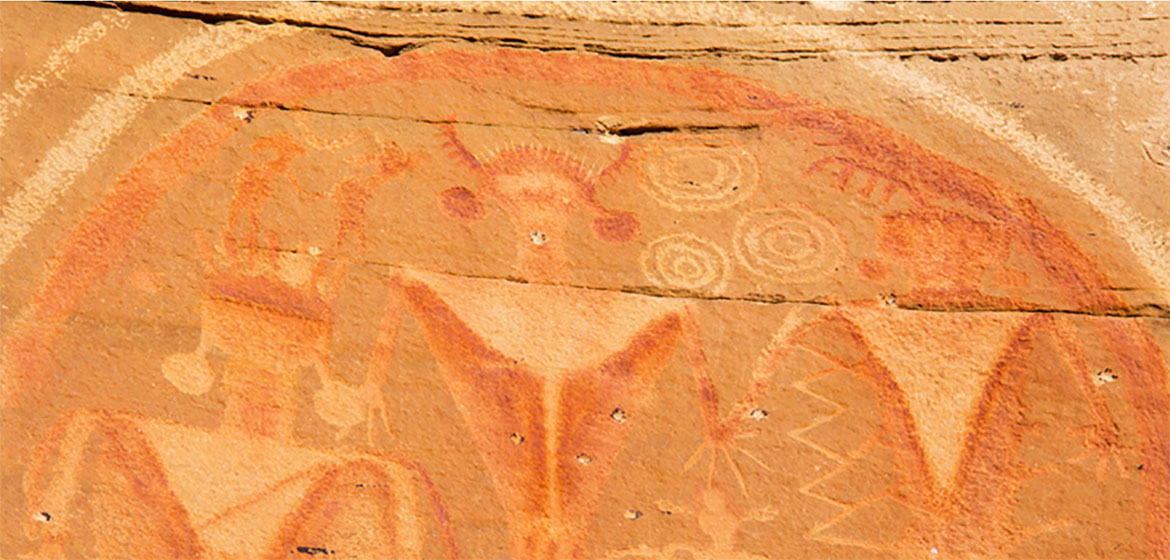By Sam Schipani
While the Ancestral Puebloan people of the Southwest were building citadels like , the were carving mysterious petroglyphs depicting horned, broad-shouldered triangular men and sweeping carvings of desert snakes. Nowhere is their legacy more apparent than in eastern Utah's Molen Reef. Fremont artifacts dominate this cultural heritage site, but its rock art ranges from 3,000-year-old panels from the Barrier Canyon tradition to etchings by Mormon pioneers crossing the Utah desert.
They aren't easy to see, but that's not a bad thing. You won't find these cultural treasures on a map, and Jonathan Bailey, a Ferron, Utah-based photographer and author of , thinks it should stay that way. "There are hundreds of rock art panels in the Molen Reef, and maybe a dozen are known," he said. "They are mostly pristine, unexcavated sites that have very little vandalism."
Bailey worries about the resources being compromised by human activity before they can be cataloged and protected. But the Bureau of Land Management (BLM) has different plans for the area. In January 2018, the agency approved the leasing of 32,000 acres for mineral exploration between the San Rafael Swell and Molen Reef—just as it has in . In Molen Reef, instead of highly publicized conservation efforts led by environmental organizations, tribal groups, or multibillion-dollar outdoor recreation outfitters, the resistance is being led by a scrappy group of rock art enthusiasts fighting to save the sites they love to explore.
The (URARA) has been protesting oil and gas leasing in the area for years. The group works with environmental organizations and others because "wilderness concerns cross over with rock art concerns." But it avoids taking partisan stances. "We're an organization of both Republicans and Democrats," said Diane Orr, cochair of URARA's conservation and preservation committee. "Our concern with oil and gas leases is when the leasing process does not carefully look at all the resources in the area and really evaluate what needs to be protected."
In the past, Orr, Bailey, and other rock art enthusiasts have been able to persuade the BLM to defer leasing while they conduct field work to document petroglyphs, habitation sites and geoglyphs that might be impacted by development. But in 2018, guided by the Trump administration's "energy dominance" agenda, the BLM's Price field office has overruled URARA's protests.
"This is the first year we have not been able to withdraw these leases," said Bailey.
Federal law obligates the BLM to analyze lands nominated for leasing and offer them at auction if it determines that leasing will not harm non-energy resources. Despite the determination of his two predecessors that leasing could damage the rock art, current BLM state director Ed Roberson concluded it would not.
"BLM conducts additional site specific analysis before any surface disturbing activities can occur," maintains Heather O'Hanlon, BLM's Utah information officer, in an email. "Strong stipulations ... give us confidence that we can protect the cultural resources entrusted under our care."
The rock art army is not reassured. Though O'Hanlon claims that "the BLM-Utah completed the most intensive pre-lease inventory survey that we have ever done," Bailey said that the agency has yet to inventory many rock art sites around Molen Reef. "They have not inventoried a good chunk of this land, so they can't judge the impacts," he said.
"In this instance, BLM has essentially punted on that issue," said Landon Newell, staff attorney at the . "They've deferred the majority of their analysis to a future date, even though they're required to inventory and document the presence of cultural resources in the beginning."
Following January's decision to proceed, the BLM put 15 parcels east of Molen Reef up for auction. After none received the minimum $2-an-acre bid at auction, the leases opened up for sale. Liberty Petroleum out of Great Neck, New York, was then able to buy 4,934 acres for $1.50 each, in what the rock art community considers the three most sensitive lease areas. The company has a history of holding on to leases without developing them (opponents believe the company is waiting for a more favorable market), but once a lease is issued, the BLM is contractually obligated to accommodate extraction.
Local Utah officials hold out hope that they can have it all. "We believe we can enjoy all the resources," said Ray Pederson, director for Emery County, where the San Rafael Swell and Molen Reef are located. "We don't want to sacrifice certain resources to develop others, we just want to develop them in a manner that allows us to enjoy all of them. We believe we can do that."
Rock-art enthusiasts and conservationists strongly disagree. Oil and gas exploration will irreparably impact the area's cultural and natural resources, they say. Since Molen Reef is largely untouched, speculators would have to start from scratch, with new roads, new pipelines, new well pads. The development would prevent the area from ever achieving protection under the Wilderness Act, and the dust kicked up from developers driving in and out would damage pristine rock art panels, not to mention the fact that new roads would likely bring looters and vandals.
In a curious footnote, on May 9, Utah representative John Curtis and senator Orrin Hatch introduced a bill that would set aside more than a half million acres of wilderness in Emery County and create a national monument at the Cleveland-Lloyd Dinosaur Quarry as well as 383,380 acres of national conservation areas, mostly in the San Rafael Swell. Sierra Club Utah chapter director Ashley Soltysiak calls the legislation a "faux-conservation bill" that "simply does not protect enough of the wilderness areas." She notes that the bill conspicuously excludes some key areas, among them Molen Reef.
"We know they are interested in the Molen Reef for energy development, and we know they are aware of the cultural significance of Molen Reef," said rock art photographer Bailey, "so we have to wonder why it's left out."
Source:
Related to SDG 10: Reduced inequalities and SDG 7: Affordable and clean energy



